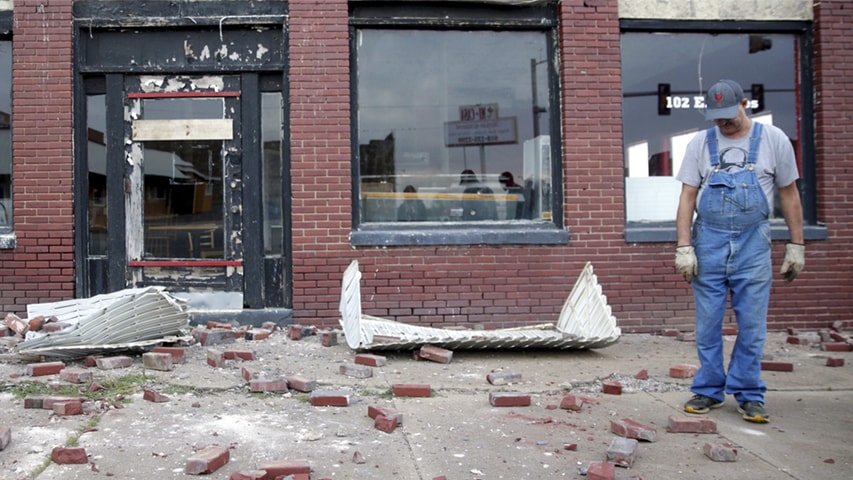Oklahoma Quakes: Researchers Say Wastewater May be Reason

Kelvin Baker looks at damage done to a building in Cushing, Okla. on Monday, Nov. 8, after an earthquake shook the area on Sunday evening. Mike Simons/Tulsa World. All rights reserved. Reprinted with permission.
In 2015, residents of Oklahoma felt the earth move beneath them 907 times, 43 times more than they've felt it move in the past eight years. On Nov. 6, it moved again in Cushing, Okla., where dozens of buildings were damaged by a 5.0 magnitude earthquake. Why the dramatic shakeup?
According to earthquake researchers, including Carnegie Mellon University Ph.D. candidate Pengyun Wang, wastewater injection and other fluid injection technologies have something to do with it.
Along with his advisers Civil and Environmental Engineering (CEE) Professor Mitchell Small and Assistant Professor Matteo Pozzi, and collaborator William Harbert, professor of geology and environmental science at the University of Pittsburgh, Wang has spent the last two years investigating the dramatic increase in seismic activity in Oklahoma. While it is difficult to draw causal relationships in earthquake research, the glut of earthquake data in Oklahoma provides researchers with a unique opportunity to study the link between seismic activity and fluid injection.
"Because the earthquake activity there has seen such a significant increase, the state has an impressive network of monitoring infrastructure," said Wang, who is pursuing his doctorate in civil and environmental engineering. "They have installed a huge number of sensors across the state, and the database of the readings they collect is well-organized and open to the public."
Fluid injection is the process by which wastewater, brine or other fluids are shot through man-made openings in the earth deep into underground wells or reservoirs. Often, this is used as a disposal method for water used in hydraulic fracturing and other industrial processes that introduce chemicals into the water, which makes the water unsafe to reintroduce into the environment.
Based on the data gathered in Oklahoma, the researchers have come up with several mechanisms explaining how fluid injection might be causing an increase in seismic activity.
"The diffusion of the injected fluid can reach nearby, critically stressed fault lines, causing these faults to slip, leading to earthquakes," Wang explained. "Additionally, if you have an underground reservoir sitting on or near a fault line, filling the reservoir with water increases its weight, putting undue strain on fault lines."
Wang and his collaborators have published two papers on the subject in the Bulletin of the Seismological Society of America. The first, titled "Statistical method for early detection of changes in seismic rate associated with wastewater injections," details research focused on detecting these earthquakes when they first start. The second, titled "A Bayesian approach for assessing seismic transitions associated with wastewater injections," works to quantify the intensity of the seismicity over time. Their third study, which the team is conducting, takes these previous studies a step further by working to locate exactly where earthquakes are occurring and how they evolve over time.
Using the data, Wang has built a model that will ultimately help regulators who supervise wastewater injection to make better decisions when considering where and when to inject and store wastewater. Using this model, regulators who are worried there might be an association between increased earthquake activity in their region and wastewater injection can evaluate individual situations to reduce the risk of making the seismicity worse.
Wang hopes to develop this model further to take past seismic trends and project them into the future by comparing seismic readings with injection data to potentially find correlations. In this way, the team's research could be used to make recommendations for future injection plans.
"I hope this research will be useful in decision-making by revealing the past evolution of induced seismicity in the region," Wang said. "If local residents of the area are experiencing the negative effects of increased seismicity and want to do something about it, without scientific evidence like this, these people might be powerless to argue against the owners of the wells. But if you can somehow give them evidence, I think it can improve overall awareness of the issue."